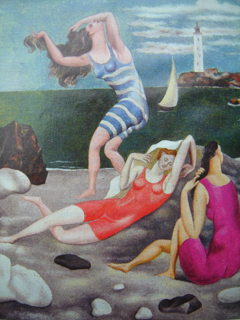The second of this month’s five summer pictures is Women Bathing, by Pablo Picasso. The artist painted this small beach scene in a charmingly naïve style that hovers somewhere between that of children’s illustration and that of the so-called “primitive”, Henri “Le Douanier” Rousseau, whose work Picasso both admired and collected. The picture was created in the summer of 1918, just after the conclusion of the First World War; and it is in part, perhaps, a celebration of the outbreak of peace. It can be seen in the Musee Picasso, in Paris.
There is a theatrical backdrop to the painting. During the war years, Picasso had become friends with the poet and critic Jean Cocteau, with whom he agreed to collaborate on Parade, an avant-garde ballet, with music by Eric Satie. Parade was devised for the impresario Serge Diaghilev and his troupe, the Ballets Russes. In 1917, Picasso had travelled to Rome with Cocteau to meet the members of the Ballets Russes, who were performing there at the time, and to work on his stage designs for the new piece. It was his first trip to Italy, and he travelled to Florence and Naples as well as Rome. The experience of seeing the great masterpieces of Renaissance and Baroque art encouraged him in his return to the human figure as a source of inspiration, after long years of Cubist experimentation, when his principal goal had been to challenge the spatial assumptions of traditional figurative art, and when his chosen subjects had for the most part been still lifes. He also visited Pompeii and was struck by the graphic simplicity and frequently direct eroticism of ancient Roman mural painting – another, distant influence, perhaps, on the picture reproduced here.
A new woman entered Picasso’s life at...


